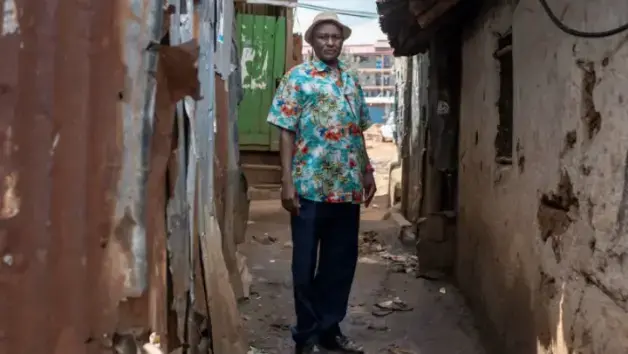
View the original version of this story at Devex
KIBERA, Kenya—Sunday morning in Kibera, Kenya's largest slum, is a hive of activity. The narrow, muddy roads are busy, and the air is a mix of praise songs from churches already into their morning mass. The atmosphere in Christ Miracle Church for all Nations, an evangelical church in Laini Saba area of Kibera, is electric. Members dance in praise as huge loudspeakers blare music from the rectangular building.
The praise and worship last over an hour before the sermon starts, which is punctuated by more song and dance. Inside, churchgoers sit on plastic chairs to the right of the entrance facing the dais, which has two green pulpits. The senior pastor, Daniel Wambua sits on the left-hand corner on a red threadbare couch facing his congregants.
The scene is not unlike other churches in other slums in Kenya. The difference is that Christ Miracle Church for all Nations holds its sermons in what was intended to be a public toilet.
The building the church now occupies is one of the dozens of public toilet facilities built by the government in 2014 in a bid to improve sanitation in Kibera. But the facilities failed to become fully functional due to inadequate sewage systems and lack of access to water. Youth groups, meant to manage these facilities for income, lacked sufficient resources to address repair and equipment issues that arose soon after construction.
Kibera, like other informal settlements in Kenya, continues to face challenges with poor sanitation.
“It is very easy to step on human feces when you are walking because it is everywhere,” said Kioko Ndolo, a resident of Laini Saba. The toilets available for use by the residents are mostly shared sanitation facilities, which are privately-owned and pay-for-use. Most of them charge 5 Kenyan shillings (5 cents) per use.
At the same time, the number of organizations providing sanitation facilities in Kibera has increased. These include Umande Trust, which runs biocenters, and Peepoople, which offers single-use, biodegradable sanitation bags to residents. Umande Trust’s biocenters include toilets, bathrooms, public kitchens, offices, and even partial waste treatment facilities.
Despite these efforts, many of Kibera’s residents still lack dependable access to sanitary facilities. They get by with a relatively small number of private toilets, or defecate in plastic bags, which are then thrown into sewers or open trenches — a practice known as “flying toilets.”
Even these options require some payment, which many in Kibera cannot afford on a daily basis. As a result, open defecation remains common.
The 2016 Kenya Environmental Sanitation and Hygiene Policy reported that in informal urban settlements, less than 20 percent of the population has access to sanitation, and 80 percent of facilities are shallow pit latrines that pollute the environment. The same report found a 14 percent national open defecation rate. According to World Health Organization research cited in Kenya’s sanitation and hygiene policy, lack of sanitation is a major contributor to mortality and morbidity in Kenya, second only to unsafe sex.
On World Toilet Day in 2014, the Ministry of Devolution and ASAL launched its program to construct 180 public toilets in the sprawling Kibera slum. The National Youth Service of Kenya, an arm of government involved in construction, was tasked with constructing the toilets and sewer lines that would connect them to the main sewage line in Kibera. The project was billed as the largest and most ambitious government project ever attempted in the slum.
Upon completion, the public toilets were handed over to youth groups who were supposed to manage them.
It was an upbeat moment when the groups in Laini Saba were given the keys to a brand new and functioning public toilet. The green, iron sheet roofed structure was a business premise, a hope for these youth to escape biting poverty. They charged five shillings to use the toilet and 10 shillings to take a shower.
The project ran smoothly for a few weeks, but then the youth groups started experiencing problems. First came the water shortages, forcing them to buy water from vendors and eroding their profit margins.
“They [the government] did not even provide a water tank for storage of water,” Ndolo said.

Soon, the youth groups realized that a blockage was preventing the toilet from draining all the way to the main sewer line. Joseph Mulwa, a resident of Laini Saba whose house was nearby, said the toilet’s drainage system was not adequately inclined to allow the effluent to flow into the main line. The youth needed to replace the pipe connecting the toilet to the main sewage line, which was also faulty.
“The main sewage line is also [damaged], and even if the toilet line was flowing well without a blockage, the sewage would still drain to the open trenches along the roads in front of people’s houses and businesses,” Mulwa said.
The youth group could not afford to buy a pipe and therefore closed the public toilet. At that point, they decided to rent the building out for another purpose.
“We had five toilets here in Laini Saba … Two have been converted into churches, but the other three are working,” Mulwa said.
Meanwhile, Wambua will continue preaching at Christ Miracle Church for all Nations in Laini Saba, making rent payments to the youth who manage the building.
Continue reading the series, Part 5: Promises kept? Residents stranded in temporary shelters after housing project stalls and learn more about What Went Wrong? here.









